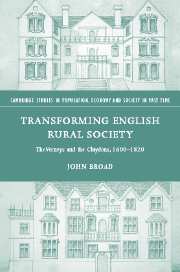Book contents
- Frontmatter
- Contents
- List of figures
- List of tables
- Preface
- Acknowledgements
- Note on editorial practice
- List of abbreviations
- 1 Introduction
- Part I Re-establishing a gentry family 1600–1657
- Part II The shaping of family and village 1657–1740
- 5 Land, business, and dynastic advance 1657–1736
- 6 The making of a modern landed estate
- 7 Power in the community – the making of an estate village 1660–1740
- Part III The great estate and estate communities c. 1700–1820
- Appendix A Sir Ralph Verney's confessional letter of 1650
- Appendix B The genealogy of the Verney family
- Bibliography
- Index
7 - Power in the community – the making of an estate village 1660–1740
Published online by Cambridge University Press: 03 July 2009
- Frontmatter
- Contents
- List of figures
- List of tables
- Preface
- Acknowledgements
- Note on editorial practice
- List of abbreviations
- 1 Introduction
- Part I Re-establishing a gentry family 1600–1657
- Part II The shaping of family and village 1657–1740
- 5 Land, business, and dynastic advance 1657–1736
- 6 The making of a modern landed estate
- 7 Power in the community – the making of an estate village 1660–1740
- Part III The great estate and estate communities c. 1700–1820
- Appendix A Sir Ralph Verney's confessional letter of 1650
- Appendix B The genealogy of the Verney family
- Bibliography
- Index
Summary
This chapter examines how the Verneys created an estate village at Middle Claydon by influencing a whole range of activities in the community. Middle Claydon's population fell from around 250 to 100 between 1660 and 1801. Population reconstitution data linked to a range of other sources demonstrates how landlord control of settlement, housing, marriage, and charity, worked together to reduce the number of labouring poor in the parish. It illuminates the important ways in which farmers, steward, and clergy interacted to make it a negotiated rather than a dictatorial process and demonstrates the complex nature of wider landlord control in the community in areas such as crime, healthcare, and morality.
Changes in landscape, farm layout, and agricultural practices in Middle Claydon after 1656 had important effects on the village community. Most striking was the considerable population decline which accelerated during the eighteenth century. Three measures of population in the sixty years after the Restoration all indicate a population of 40 to 50 households, or 180 to 250 people with a precise enumeration 206 in 1709. By 1800 this had diminished to just over 100. Middle Claydon's population decline was greater than in any other parish in north Buckinghamshire, and was probably comparable with the greatest levels of rural depopulation nationally in that period. Wrigley and Schofield found that 14 per cent of parishes had fewer average baptisms in 1801 than in the 1660s.
- Type
- Chapter
- Information
- Transforming English Rural SocietyThe Verneys and the Claydons, 1600–1820, pp. 149 - 196Publisher: Cambridge University PressPrint publication year: 2004

